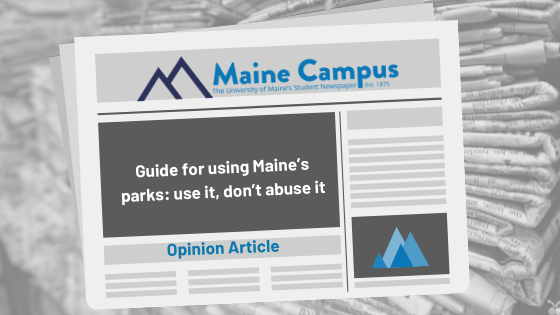There have not been many silver-linings to come out of the COVID-19 outbreak. It has been a month since the World Health Organization declared the virus as a pandemic, prompting countless businesses and schools, including the University of Maine, to suspend operations indefinitely. In response to these quarantining measures, people have flooded to state and national parks in unprecedented numbers. While it is nice to see people connect to the outdoors in times of crisis, there are serious and justifiable concerns for the parks and those that use them regarding this type of reckless congregation.
At the end of last month, the Maine Bureau of Parks and Lands (BPL) closed 10 coastal parks, as well as Acadia National Park, in response to overcrowding which stood to violate social distancing guidelines outlined by the Center for Disease Control and Prevention (CDC). The BPL is also recording usage of inland state parks such as Sebago Lake and Bradbury Mountain in order to prevent usage from reaching unsafe levels. Similar closures have occurred at national parks all over the United States in order to prevent out-of-state visitors from possibly spreading the virus.
Governments have not closed these parks to prevent or discourage people from going outside, but rather to encourage Americans to seek out smaller, local public lands, parks and land trusts in order to avoid larger congregations. Despite what some individuals might assume, Gov. Mills’ “Stay Healthy at Home” executive order does allow “engaging in outdoor exercise activities, such as walking, hiking, running, or biking” so long as individuals are complying with social distancing guidelines.
Getting outside and exercising is actually, now more than ever, one of the best things that you can do to improve your mental and physical well-being in the midst of social distancing and stay-at-home orders. According to one Outside Magazine article, exercise helps to build a stronger immune system by promoting good circulation, and exposure to sunlight increases the movement of vital cells in the immune system. For those concerned about time, in one New York Times article, kinesiology Professor Martin Gibala asserted that a full-body workout as short as five minutes a day would be enough to maintain one’s baseline fitness.
Of course, none of these benefits can be reaped if individuals are not following the CDC’s social distancing guidelines or using common sense. Most individuals are aware of the basics: stay six feet apart at all times and don’t leave the house if you feel sick. But there is also a good deal of forward thinking that one can employ in order to avoid a potentially hazardous outing. One should consider the kind of trails that they might be on if they are going for a walk or a hike. Individuals should try to find areas with wide trails or dirt roads so that they can maintain at least six feet of space between themselves and others on the trail. Similarly, if the parking lot of a recreation area is crowded or full, then the decision should be to go somewhere else. Maintaining distance on the trail is pointless if everyone is already too close together in the parking lot.
While more Americans taking advantage of the recreational and natural resources available would generally be positive, at this very moment everyone needs to consider avoiding those parks that they may frequent otherwise. Take this time to go online and look for the older or lesser known trails in your area, or simply exercise on your own road or backyard. It’s ironic, but for the sake of public health, we have to really carefully consider where and how we exercise.




